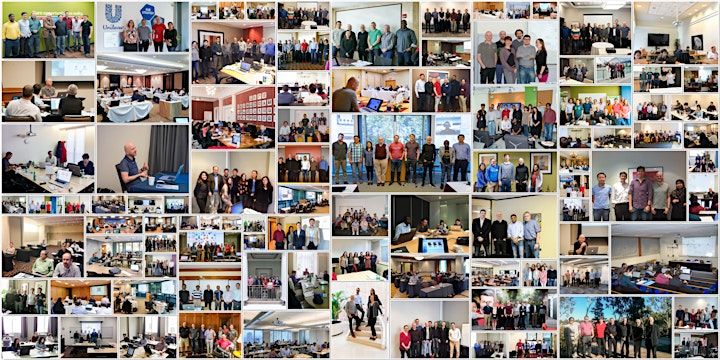
About this Event
The renowned Introductory BayesiaLab Course offers an in-depth exploration of Bayesian networks, equipping you to harness them for applied research in fields like biostatistics, marketing science, ecology, and beyond.
What sets this course apart is its hands-on approach: every theoretical module is complemented by a practical BayesiaLab session. So, as you delve into topics like knowledge modeling, causal inference, and machine learning, you can immediately apply your learning on your computer.
For many of the 2,000 or so course participants from around the world to date, Bayesian networks and BayesiaLab indispensable in their work.
Dr. Lionel Jouffe is co-founder and CEO of France-based Bayesia S.A.S. Lionel holds a Ph.D. in Computer Science from the University of Rennes and has worked in Artificial Intelligence since the early 1990s. While working as a Professor/Researcher at ESIEA, Lionel started exploring the potential of Bayesian networks.
After co-founding Bayesia in 2001, he and his team have been working full-time on the development of BayesiaLab, which has since emerged as the leading software package for knowledge discovery, data mining, and knowledge modeling using Bayesian networks. BayesiaLab enjoys broad acceptance in academic communities, business, and industry.
Day 1: Theoretical Introduction
- Bayesian Networks: Artificial Intelligence for Decision Support under Uncertainty
- Probabilistic Expert System
- A Map of Analytic Modeling and Reasoning
- Bayesian Networks and Cognitive Science
- Unstructured and Structured Particles Describing the Domain
- Expert Based Modeling and/or Machine Learning
- Predictive vs. Explanatory Models, i.e., Association vs. Causation
- Application Examples: Medical Expert Systems, Stock Market Analysis, Microarray Analysis, Consumer Segmentation, Drivers Analysis, and Product Optimization
- Cognitive Science: How Our Probabilistic Brain Uses Priors in the Interpretation of Images
- Interpreting Results of Medical Tests
- Kahneman & Tversky’s Yellow Cab/White Cab Example
- The Monty Hall Problem, Solving a Vexing Puzzle with a Bayesian Network
- Simpson’s Paradox - Observational Inference vs. Causal Inference
- Probabilistic Axioms
- Interpretation with Particles
- Joint Probability Distribution (JPD)
- Probabilistic Expert System for Decision Support: Types of Requests
- Leveraging Independence Properties
- Product/Chain Rule for Compact Representation of JPD
- Qualitative Part: Directed Acyclic Graph
- Graph Terminology
- Graphical Properties
- D-Separation
- Markov Blanket
- Quantitative Part: Marginal and Conditional Probability Distributions
- Exact and Approximate Inference in Bayesian networks
- Example of Probabilistic Inference: Alarm System
- Expert-Based Modeling via Brainstorming
- Why Expert-Based Modeling?
- Value of Expert-Based Modeling
- Structural Modeling: Bottom-Up and Top-Down Approaches
- Parametric Modeling
- Cognitive Biases
- BEKEE: Bayesia Expert Knowledge Elicitation Environment
Day 2: Machine Learning, Part 1<h4>Parameter Estimation</h4>
- Maximum Likelihood Estimation
- Bayesian Parameter Estimation with Dirichlet Priors
- Smooth Probability Estimation (Laplacian Correction)
- Information is a Measurable Quantity: Log-Loss
- Expected Log-Loss
- Entropy
- Conditional Entropy
- Mutual Information
- Symmetric Relative Mutual Information
- Kullback-Leibler Divergence
- Entropy Optimization
- Minimum Description Length (MDL) Score
- Structural Coefficient
- Minimum Size of Data Set
- Search Spaces
- Search Strategies
- Learning Algorithms
- Maximum Weight Spanning Tree
- Taboo Search
- EQ
- TabooEQ
- SopLEQ
- Taboo Order
- Data Perturbation
- Example: Exploring the relationships in Body Dimensions
- Data Import (Typing, Discretization)
- Definition of Classes
- Exclusion of a Node
- Heuristic Search Algorithms
- Data Perturbation (Learning, Bootstrap)
- Choice of the Structural Coefficient
- Console
- Symmetric Layout
- Analysis of the Model (Arc Force, Node Force, Pearson Coefficient)
- Dictionary of Node Positions
- Adding a Background Image
- Learning Algorithms
- Naive
- Augmented Naive
- Manual Augmented Naive
- Tree-Augmented Naive
- Sons & Spouses
- Markov Blanket
- Augmented Markov Blanket
- Minimal Augmented Markov Blanket
- Variable Selection with Markov Blanket
- Example: Predictions based on body dimensions
- Data Import (Data Type, Supervised Discretization)
- Heuristic Search Algorithms
- Target Evaluation (In-Sample, Out-of-Sample: K-Fold, Test Set)
- Smoothed Probability Estimation
- Analysis of the Model (Monitors, Mapping, Target Report, Target Posterior Probabilities, Target Interpretation Tree)
- Evidence Scenario File
- Automatic Evidence-Setting
- Adaptive Questionnaire
- Batch Labeling
Day 3: Machine Learning, Part 2<h4>Semi-Supervised Learning—Variable Clustering</h4>
- Algorithms
- Example: S&P 500 Analysis
- Variable Clustering
- Changing the number of Clusters
- Dynamic Dendrogram
- Dynamic Mapping
- Manual Modification of Clusters
- Manual Creation of Clusters
- Semi-Supervised Learning
- Search Tool (Nodes, Arcs, Monitors, Actions)
- Synthesis of a Latent Variable
- Expectation-Maximization Algorithm
- Ordered Numerical Values
- Cluster Purity
- Cluster Mapping
- Log-Loss and Entropy of the Data
- Contingency Table Fit
- Hypercube Cells per State
- Example: Segmentation of men based on body dimensions
- Data Clustering (Equal Frequency Discretization, Meta-Clustering)
- Quality Metrics (Purity, Log-Loss, Contingency Table Fit)
- Posterior Mean Analysis (Mean, Delta-Means, Radar Charts)
- Mapping
- Cluster Interpretation with Target Dynamic Profile
- Cluster Interpretation with Target Optimization Tree
- Projection of the Cluster on Other Variables
- PSEM Workflow
- Unsupervised Structural Learning
- Variable Clustering
- Multiple Clustering for Creating a Factor Variable (via Data Clustering) per Cluster of Manifest Variables
- Unsupervised Learning for Representing the Relationships Between the Factors and the Target Variables
- Example: The French Market of Perfumes
- Cross-Validation of the Clusters of Variables
- Displayed Classes
- Total Effects
- Direct Effects
- Direct Effect Contributions
- Tornado Analysis
- Taboo, EQ, TabooEQ, and Arc Constraints
- Multi-Quadrants
- Export Variations
- Target Optimization with Dynamic Profile
- Target Optimization with Tree

Event Venue & Nearby Stays
Spaces - Miami Beach - Lincoln Road, 1111 Lincoln Road, Miami Beach, United States
USD 1495.00 to USD 2995.00
